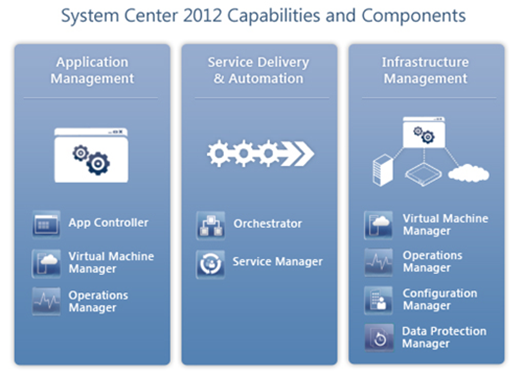Recently I spent quite some time getting to grips with Microsoft System Center (SC). I have a client that has a very large IT infrastructure environment and relies quite heavily on SC to monitor and manage it.
SC is one of those products where the question “What does it do” will prompt an answer “What do you want it to do?”. If you have not heard of System Center before, it is basically a suite of products specifically aimed at corporate IT administrators, assisting them in managing Microsoft server and desktop infrastructure.
This means that you can leverage SC (making use of the various aspects or applications ) to do everything from AD account provisioning to virtual machine creation and deployment.
TFS does have a management pack which integrates TFS very nicely with System Center Operations Manager (SCOM).
“The Team Foundation Server 2012 Monitoring Management Pack provides both proactive and reactive monitoring of Microsoft Team Foundation Server 2012. It monitors TFS components such as application tier server instances, team project collections, build servers, and proxy servers. “
So we can monitor TFS and report failures and even go as far as “escalating issues” to TFS in the form of work items.
This post however, centres around System Center Services Manager (SCSM). SCSM with its “out of the box” integration with a number of SC applications, including Orchestrator, makes it a very capable application for managing, automating and adapting your IT services.
It also provides built-in processes for incident and problem resolution, change control, and asset lifecycle management.
Has the penny dropped?
What if I mention that TFS work items provide built-in processes for incident and problem resolution, change control, and application lifecycle management.
The client that I mentioned earlier is using SCSM to manage everything from infrastructure to software requirements and changes.
The development team is using TFS and they wanted to “integrate” SCSM with TFS, reducing the effort involved to manually copy work items and progress from one system to the other. They also wanted to reduce the context switching between the applications, specifically in the development environments.
So where to start…
As I mentioned earlier, SCSM integrates very comfortably (using connectors) with a number of the SC applications. One of which, Orchestrator (previously Opalis), is basically a workflow management system. In SCSM you can invoke and execute Orchestrator workflows through a number of processes and via a number of hooks, and in Orchestrator you can configure “monitors” that poll target systems. Through Orchestrator and custom “Integration Packs” (IP) you can basically have SCSM integrate with any number of 3rd party applications.
The guys over at the Orchestrator Codeplex project had already built some IP’s for various applications and fortunately for me there is even one for TFS.
So, how did we get this going..
Firstly you need to get hold of the Integration Packs and deploy them to the Orchestrator “Runbook” server.
Then we can create the workflows that monitor SCSM for any changes in the Requirements and Manual Activities.
When a requirement is created or changed we push over that change to TFS as a User Story.
Next we find associated Manual Activities and then create or update them in TFS as Tasks that are linked to the User Story.
The same approach is followed when a change is made to a work item which is then updated in SCSM.
One problem that I did have was that the TeamFoundationServer IP was built using TFS 2008 and updated to TFS 2010. This means that work item links were not taken into account when the initial activities were created.
Fortunately it is very easy to code these custom activities (think activities in Windows Workflow Foundation) in the IP’s, and being a codeplex project I was able to grab the code and create the additional activities (I did submit a patch with the changes)
This was a very interesting learning experience, delving into yet another one of Microsoft’s application suites. This also takes TFS’s capability and makes it available into areas that you would not necessarily have considered possible, further establishing TFS as a true ALM suite.
If you would like to know more, or would like TFS integrated into SCSM. Give us a shout..





